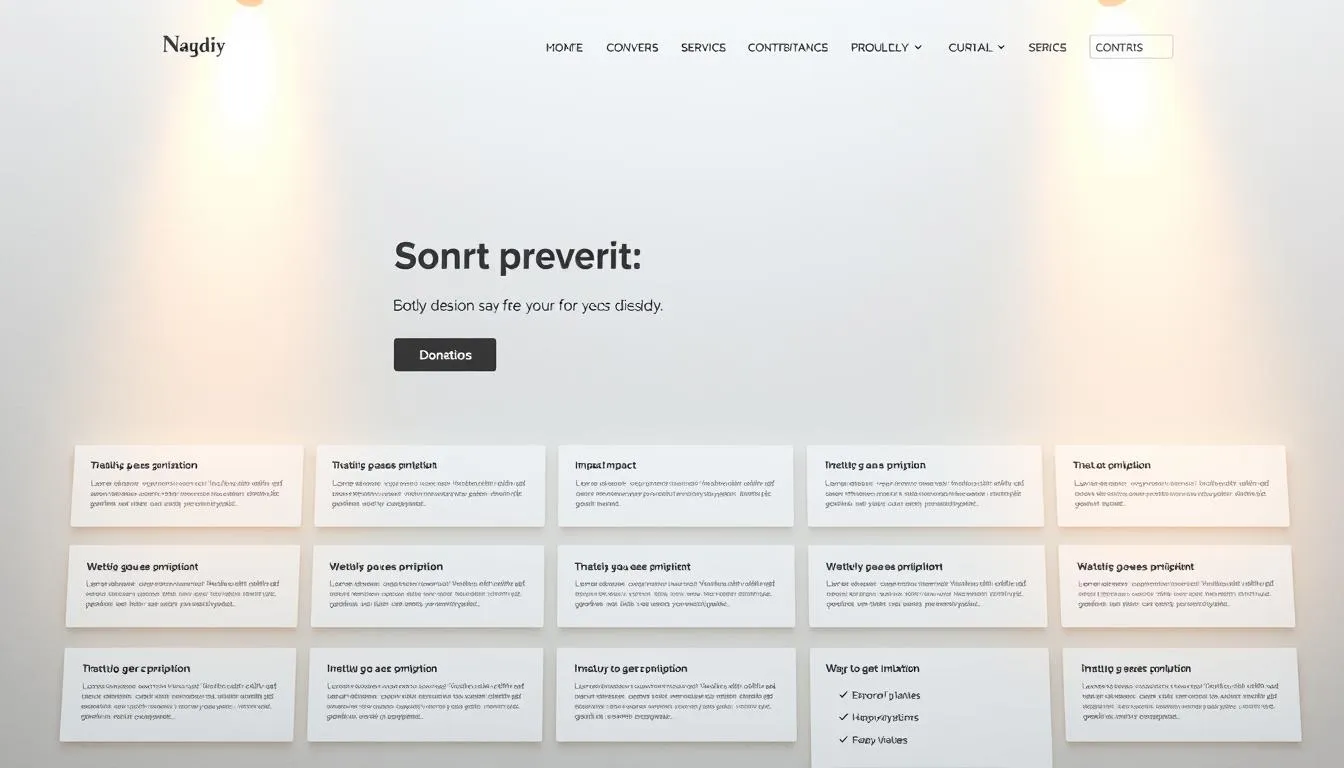Last Updated on: June 19, 2025
A well-designed non-profit website is crucial for any charity organization aiming to boost its fundraising efforts. In today’s digital age, a website is often the first point of contact between a potential donor and the charity, making it a vital tool for securing donations.
An effective charity website not only showcases the organization’s mission and impact but also provides a seamless user experience that encourages visitors to give.
By optimizing your website for donations, you can significantly enhance your organization’s ability to raise funds and achieve its goals.
Key Takeaways
- Create a user-friendly and engaging website.
- Optimize your website for donations.
- Showcase your organization’s mission and impact.
- Provide a seamless user experience.
- Enhance your fundraising efforts with a well-designed website.
The Impact of Website Design on Non-Profit Donations
The impact of website design on non-profit donations cannot be overstated, as it directly influences donor trust and loyalty. A non-profit organization’s website is often the first point of contact with potential donors, making a well-designed site crucial for securing donations.
First Impressions and Donor Psychology
When visiting a non-profit website, donors form an opinion within seconds. A cluttered or outdated design can deter potential donors, while a clean and modern aesthetic can foster trust and encourage giving. Donor psychology plays a significant role in this process, as donors are more likely to support organizations that appear professional and transparent.
The Cost of Poor Website Design
A poorly designed website can result in significant financial losses for non-profit organizations. The following table illustrates the potential costs associated with a subpar website design:
By prioritizing website design, non-profit organizations can avoid these costs and create a more effective online presence.
Essential Elements of a Donation-Generating Website
To maximize donations, non-profit organizations must ensure their website clearly conveys their purpose and impact. A donation-generating website is more than just a digital presence; it’s a powerful tool for engaging supporters and driving fundraising efforts.
Clear Mission Statement and Value Proposition
A clear and concise mission statement is vital for any non-profit website. It should be prominently displayed on the homepage, providing visitors with a quick understanding of the organization’s goals and values. As Simon Sinek once said, “People don’t buy what you do; they buy why you do it.” A compelling value proposition communicates the unique benefits of supporting your cause.
Compelling Visual Storytelling
Visual storytelling is a potent way to connect with potential donors on an emotional level. Using high-quality images, videos, and infographics, non-profits can convey the impact of their work and the difference donations can make. Compelling visuals can capture attention and inspire action more effectively than text alone.
Social Proof and Impact Metrics
Donors want to know that their contributions are making a real difference. By showcasing success stories, testimonials, and impact metrics, non-profits can build trust and credibility with potential supporters. “The most effective way to build trust is to show the impact of donations,” notes a study on non-profit fundraising. Providing transparent and tangible results can significantly boost donation rates.
Optimizing Your Donation Page for Maximum Conversions
To boost online giving, it’s essential to streamline your donation page for maximum conversions. A donation page that is easy to navigate and understand can significantly impact the number of donations your non-profit receives.
Streamlining the Donation Process
A cluttered or complicated donation process can deter potential donors. Simplify your donation page by reducing the number of form fields and steps required to complete a donation. Use a clear and concise donation form that asks for only the necessary information.
Implementing Multiple Donation Options
Offering various donation options can cater to different donor preferences. Consider providing one-time, monthly, and recurring donation options. This flexibility can encourage more people to give.
Using Suggested Donation Amounts
Guiding donors with suggested donation amounts can help increase the average donation size. Anchor your suggested amounts around your organization’s typical donation to make them more relatable and achievable for donors.
Creating Urgency with Limited-Time Matches
Creating a sense of urgency can motivate donors to give sooner rather than later. Consider implementing limited-time matching gift campaigns to encourage donations. This strategy can be particularly effective during special events or fundraising drives.
Creating Content That Inspires Giving
The key to unlocking donations lies in creating content that tells a story, evokes emotion, and inspires action. Compelling content is vital for non-profit organizations aiming to engage donors and drive donations.
Storytelling Techniques That Drive Donations
Storytelling is a powerful tool for non-profits. By sharing the stories of those impacted by their work, organizations can create an emotional connection with potential donors. Effective storytelling involves highlighting the challenges, successes, and ongoing needs of the people or causes they support.
For instance, instead of just stating statistics, a non-profit could share a specific example: “Meet Jane, a single mother who benefited from our food bank program. With your support, she can now provide for her children.” Such narratives make the mission more relatable and personal.
Balancing Emotional Appeal with Data
While emotional stories capture attention, data provides credibility and context. Balancing both elements is crucial for building trust with donors. For example, pairing a heartfelt story with statistics on the impact of donations can be particularly effective.
“We helped 500 families last year, but without your support, we wouldn’t have been able to provide for even half of them.”
Content Calendar for Year-Round Engagement
Maintaining a content calendar helps non-profits stay organized and ensures consistent engagement with donors throughout the year. A well-planned calendar includes a mix of storytelling, updates on projects, and calls to action.
By incorporating these strategies, non-profits can create a content-rich environment that inspires giving and fosters a loyal community of supporters.
How to Increase Donations with a Non-Profit Website? Proven Strategies
Effective online fundraising for non-profits involves leveraging recurring donations, membership programs, and targeted campaigns. By implementing these strategies, non-profits can significantly enhance their fundraising efforts and build a loyal donor base.
Implementing Recurring Donation Programs
Recurring donation programs allow non-profits to receive regular, predictable donations from supporters. This can be achieved by offering monthly giving options on the website, making it easy for donors to contribute regularly.
Creating Membership Tiers and Benefits
Developing membership tiers with associated benefits can incentivize donors to give more. For example, different tiers could offer exclusive updates, event access, or recognition on the website.
Leveraging Special Events and Campaigns
Organizing fundraising events and campaigns can drive donations and engage the community. This could include online campaigns, charity runs, or auctions, all promoted through the non-profit website.
By incorporating these proven strategies, non-profits can enhance their online fundraising capabilities and attract more donors.
Mobile Optimization for On-the-Go Donors
With the rise of mobile giving, it’s crucial for non-profits to ensure their websites are optimized for mobile devices to provide a seamless donor experience. As more people use their smartphones to browse and donate, a mobile-friendly website can significantly impact your organization’s ability to secure funds.
Mobile-First Design Principles
Adopting a mobile-first design approach ensures that your website is inherently responsive and provides an optimal viewing experience across various devices. This involves prioritizing content, simplifying navigation, and ensuring that calls-to-action, such as donation buttons, are prominently displayed.
Simplifying Mobile Donation Forms
To streamline the donation process on mobile devices, it’s essential to simplify donation forms. This can be achieved by reducing the number of fields, using auto-fill options where possible, and ensuring that the form is easily accessible on smaller screens.
Testing Across Multiple Devices
Testing your website across multiple devices and browsers is crucial to ensure that the donor experience is consistent and hassle-free. Regular testing helps identify and fix issues that could deter potential donors, thereby maximizing your online fundraising potential.
Building Trust and Transparency with Potential Donors
Establishing trust with potential donors is crucial for the success of any non-profit organization. Donors want to ensure that their contributions are being used effectively and efficiently. To build this trust, non-profits must demonstrate transparency and accountability in their operations.
Showcasing Financial Accountability
One way to demonstrate transparency is by showcasing financial accountability. This can be achieved by:
- Publishing annual financial reports
- Providing clear information on how donations are used
- Displaying financial information prominently on the website
“Transparency is the new currency in the non-profit sector,” says Dan Pallotta, a well-known non-profit expert. By being open about financial dealings, non-profits can build credibility with potential donors.
Highlighting Success Stories and Testimonials
Another way to build trust is by highlighting success stories and testimonials from existing donors or beneficiaries. This can be done through:
- Case studies of successful projects
- Testimonials on the website and social media
- Sharing stories of impact through various media channels
By sharing real-life examples of the impact of donations, non-profits can demonstrate their effectiveness and build trust with potential donors.
Security Badges and Privacy Assurances
To further establish trust, non-profits should ensure their donation process is secure. This can be achieved by:
- Displaying security badges on the donation page
- Providing clear privacy assurances
- Using HTTPS encryption for the donation process
By implementing these measures, non-profits can create a trustworthy environment for donors, ultimately leading to increased donations and support.
Making Your Non-Profit Website Accessible to All Donors
Accessibility is not just a legal requirement; it’s a moral imperative for non-profits. Ensuring your website is accessible to all donors can significantly impact your donation rates and overall success.
ADA Compliance Best Practices
To be ADA compliant, your website should follow the Web Content Accessibility Guidelines (WCAG 2.1). This includes providing alternative text for images, ensuring keyboard navigation, and using clear and consistent navigation.
- Use alt text for all images
- Ensure all interactive elements are accessible via keyboard
- Use clear and consistent headings
Inclusive Design for Diverse Audiences
Inclusive design means creating a website that is usable by everyone, regardless of their abilities. This involves using clear language, providing transcripts for audio and video content, and ensuring that your website is navigable by screen readers.
Multilingual Support for Broader Reach
Offering multilingual support can significantly broaden your donor base. Consider translating your website into languages spoken by your target audience.
Leveraging SEO to Attract More Potential Donors
In the digital age, non-profit organizations must harness the power of Search Engine Optimization (SEO) to increase their online visibility and attract more donors. By optimizing their website for search engines, non-profits can reach a wider audience and drive more traffic to their donation pages.
Keyword Research for Non-Profit Organizations
Effective SEO begins with thorough keyword research. Non-profits should identify relevant keywords and phrases that potential donors might use when searching for causes like theirs. Tools such as Google Keyword Planner and Ahrefs can help in discovering these keywords. For instance, a non-profit focused on environmental conservation might target keywords like “eco-friendly donations” or “support environmental causes.”
Local SEO Strategies for Community Engagement
For non-profits with a local presence, local SEO strategies are crucial. This involves optimizing the website for location-based searches by including the name of the city or region in keywords and meta tags. Claiming and optimizing the Google My Business listing is also essential, as it helps the non-profit appear in local search results and on Google Maps.
Content Optimization for Cause-Related Searches
Optimizing content for cause-related searches involves creating high-quality, relevant content that addresses the needs and interests of potential donors. This can include blog posts about the non-profit’s work, success stories, and the impact of donations. Using long-tail keywords related to the cause can help in attracting specific searches. For example, “how to donate to animal shelters” or “supporting education for underprivileged children.”
By implementing these SEO strategies, non-profits can enhance their online visibility, attract more potential donors, and ultimately increase donations.
Integrating Social Media with Your Donation Strategy
By leveraging social media effectively, non-profits can create a robust donation strategy that resonates with supporters. Social media platforms offer a unique opportunity to engage with a wider audience, build a community around your cause, and drive donations.
Cross-Platform Promotion Techniques
To maximize your social media impact, it’s essential to implement cross-platform promotion techniques. This involves sharing your donation campaigns across multiple social media platforms such as Facebook, Twitter, Instagram, and LinkedIn. By doing so, you can reach a broader audience and encourage sharing and donations.
Key strategies include:
- Sharing compelling content that highlights your mission and impact
- Utilizing relevant hashtags to increase visibility
- Engaging with your followers through comments and direct messages
- Running targeted social media ads to reach potential donors
Creating Shareable Donation Campaigns
Crafting shareable donation campaigns is crucial for spreading the word about your cause. To create a shareable campaign, focus on storytelling, use high-quality visuals, and make sure your message is clear and concise.
Effective campaign elements include:
Leveraging Social Proof for Increased Donations
Social proof is a powerful motivator for potential donors. By showcasing testimonials, success stories, and the impact of previous donations, you can build trust and encourage more people to donate.
By integrating these strategies into your donation approach, you can harness the full potential of social media to drive donations and support your non-profit’s mission.
Using Analytics to Improve Donation Conversion Rates
Effective use of analytics can transform a non-profit’s website into a powerful donation-generating tool. By understanding how donors interact with their website, non-profits can identify areas for improvement and optimize their donation processes.
Key Metrics for Donation Page Performance
To evaluate the success of a donation page, non-profits should track key metrics such as conversion rate, average donation amount, and donor retention rate. Conversion rate is particularly important, as it indicates the percentage of visitors who complete a donation.
Google Analytics for Non-Profit Donation Tracking
Google Analytics is a powerful tool for tracking donation page performance. By setting up goals and events, non-profits can monitor how visitors navigate their website and identify bottlenecks in the donation process. Goal tracking allows organizations to measure the success of their donation pages.
A/B Testing for Donation Elements
A/B testing involves comparing two versions of a donation page to determine which one performs better. Non-profits can test different elements such as donation amounts, call-to-action buttons, and images to optimize their donation pages.
Heat Mapping to Identify User Behavior
Heat mapping is a technique used to visualize how users interact with a webpage. By analyzing heat maps, non-profits can identify areas of their donation page that receive the most attention and optimize their design accordingly. This can help improve the overall user experience and increase conversion rates.
Conclusion: Transforming Your Website into a Donation Powerhouse
By implementing the strategies outlined in this article, your non-profit organization can significantly enhance its online presence and increase donations. Effective non-profit website optimization is crucial to achieving this goal.
A well-designed website is more than just a digital presence; it’s a powerful tool for driving donations and supporting your mission. By streamlining the donation process, leveraging social media, and optimizing your website for search engines, you can create a seamless giving experience for your supporters.
As you continue to refine your website and donation strategy, remember that turning your site into a donation powerhouse requires ongoing effort and optimization. Regularly reviewing your website’s performance using analytics tools will help you identify areas for improvement and maximize your online fundraising potential.
By putting these strategies into practice, you’ll be well on your way to creating a robust online presence that inspires giving and supports your organization’s mission.
FAQ
What is the most important element of a non-profit website for increasing donations?
A clear mission statement and compelling visual storytelling are crucial for communicating your organization’s purpose and the impact of donations, thereby encouraging donors to give.
How can I optimize my donation page for maximum conversions?
Streamlining the donation process, implementing multiple donation options, and using suggested donation amounts can significantly improve conversion rates. Additionally, creating a sense of urgency with limited-time matches can motivate donors to give.
Why is mobile optimization important for non-profit websites?
With the rise of mobile giving, ensuring your website is optimized for mobile devices is crucial for providing a seamless donor experience. Mobile-first design principles, simplifying mobile donation forms, and testing across multiple devices are essential for maximizing mobile donations.
How can I build trust with potential donors on my website?
Showcasing financial accountability, highlighting success stories and testimonials, and using security badges and privacy assurances can foster trust and transparency with potential donors, making them more likely to donate.
What role does SEO play in attracting potential donors to my non-profit website?
SEO is a powerful tool for attracting potential donors by increasing your website’s visibility in search engine results. Conducting keyword research, implementing local SEO strategies, and optimizing content for cause-related searches can drive more traffic to your site.
How can I leverage social media to amplify my donation strategy?
Cross-platform promotion techniques, creating shareable donation campaigns, and leveraging social proof can significantly amplify your donation strategy. Social media can help increase donations by reaching a wider audience and encouraging sharing and engagement.
What analytics tools can I use to improve donation conversion rates on my website?
Google Analytics is a powerful tool for tracking donations and evaluating donation page performance. A/B testing for donation elements and using heat mapping to understand user behavior can also provide valuable insights for optimizing conversion rates.
How can I make my non-profit website accessible to all donors?
Ensuring ADA compliance, practicing inclusive design for diverse audiences, and offering multilingual support can make your website more accessible to a broader range of donors, thereby increasing your potential donor base.




